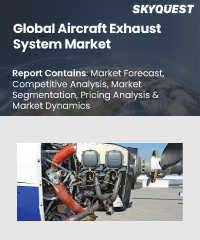
Product ID: SQMIG20S2018

Report ID:
SQMIG20S2018 |
Region:
Global |
Published Date: April, 2024
Pages:
202
|
Tables:
153 |
Figures:
76
Global Aircraft Exhaust System Market size was valued at USD 1.01 billion in 2022 and is poised to grow from USD 1.09 billion in 2023 to USD 2.04 billion by 2031, at a CAGR of 8.13% during the forecast period (2024-2031).
The rapid increase in air passengers and the strong demand for new aircrafts are two factors that propels the development of the aircraft exhaust system market.
Secondly, the market share for aircraft exhausts also receives a boost in demand for lightweight energy efficient and reduced gas emissions aircraft. The development of 3D printing technology for the fabrication of exhaust systems as well as their use in system improvement and advancement also stimulate industrial growth.
On the other hand, high installation and operating costs are likely to constrain global aircraft exhaust system markets. There is a backlog of new aircraft deliveries, and regulators & laws about safety and maintenance of the aircrafts. All these factors are taking their toll on market growth in the aviation wearable Exhaust System.
Their exhaust systems increase the efficiency of aircraft fuel, so they increase the productivity and total effectiveness of aircraft. These systems carry off toxic emissions from the engine and fuselage to protect the aircraft and its passengers. Besides governments and major firms are enacting programs, so that the technological upgrade of aircraft exhaust systems is another significant factor contributing to market revenue growth.
For instance, the development of the next-generation combat aircraft is currently being developed. These efforts include enhancing stealth aircraft and fighter plane designs to give exhaustible heat minimization and passive sensors installation to lower electromagnetic (EM) emissions.
Likewise, the Defence Advanced Research Projects Agency (DARPA) of the United States is researching Active Flow Control (AFC) as part of its X-Plane Control of Revolutionary Aircraft with Novel Effectors (CRANE) Programme.
Our industry expert will work with you to provide you with customized data in a short amount of time.
REQUEST FREE CUSTOMIZATIONWant to customize this report? This report can be personalized according to your needs. Our analysts and industry experts will work directly with you to understand your requirements and provide you with customized data in a short amount of time. We offer $1000 worth of FREE customization at the time of purchase.

Product ID: SQMIG20S2018